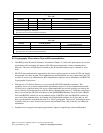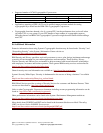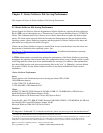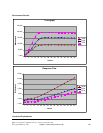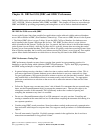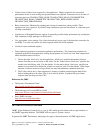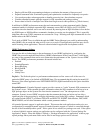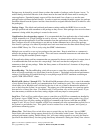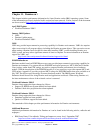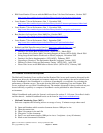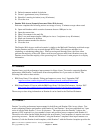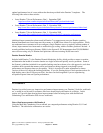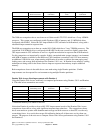Packages may be shared by several clients to reduce the number of packages on the System i server. To
enable sharing, the default libraries of the clients must be the same and the clients must be running the
same application. Extended dynamic support will be deactivated if two clients try to use the same
package but have different default libraries. In order to reactivate extended dynamic support, the package
should be deleted from the System i and the clients should be assigned different libraries in which to store
the package(s).
Package Usage: The default and preferred performance setting enables the ODBC driver to use the
package specified and adds statements to the package as they are run. If the package does not exist when a
statement is being added, the package is created on the server.
Considerations for using package support: It is recommended that if an application has a fixed number
of SQL statements in it, a single package be used by all users. An administrator should create the
package and run the application to add the statements from the application to the package. Once that is
done, configure all users of the package to not add any further statements but to just use the package.
Note that for a package to be shared by multiple users each user must have the same default library listed
in their ODBC library list. This is set by using the ODBC Administrator.
Multiple users can add to or use a given package at the same time. Keep in mind that as a statement is
added to the package, the package is locked. This could cause contention between users and reduce the
benefits of using the extended dynamic support.
If the application being used has statements that are generated by the user and are ad hoc in nature, then it
is recommended that each user have his own package. Each user can then be configured to add
statements to their private package. Either the library name or all but the last 3 characters of the package
name can be changed.
RecordBlocking: The RecordBlocking switch allows users to control the conditions under which the
driver will retrieve multiple rows (block data) from the System i. The default and preferred performance
setting to Use Blocking will enable blocking for everything except SELECT statements containing an
explicit "FOR UPDATE OF" clause.
BlockSizeKB (choices 2 through 512): The BlockSizeKB parameter allows users to control the number
of rows fetched from the System i per communications flow (send/receive pair). This value represents the
client buffer size in Kilobytes and is divided by the size of one row of data to determine the number of
rows to fetch from the System i in one request. The primary use of this parameter is to speed up queries
that send a lot of data to the client. The default value 32 will perform very well for most queries. If you
have the memory available on the client, setting a higher value may improve some queries.
LazyClose: The LazyClose switch allows users to control the way SQLClose commands are handled by
the System i Access ODBC Driver. The default and preferred performance setting enables Lazy Close.
Enabling LazyClose will delay sending an SQLClose command to the System i until the next ODBC
request is sent. If Lazy Close is disabled, a SQLClose command will cause an immediate explicit flow to
the System i to perform the close. This option is used to reduce flows to the System i, and is purely a
performance enhancing option.
LibraryView: The LibraryView switch allows users to control the way the System i Access ODBC
Driver deals with certain catalog requests that ask for all of the tables on the system. The default and
preferred performance setting ‘Default Library List’ will cause catalog requests to use only the libraries
specified in the default library list when going after library information. Setting the LibraryView value to
IBM i 6.1 Performance Capabilities Reference - January/April/October 2008
© Copyright IBM Corp. 2008 Chapter 10 - DB2 for i5/OS JDBC and ODBC 155



